Sonos Connect with Wyred4Sound reclocker modification
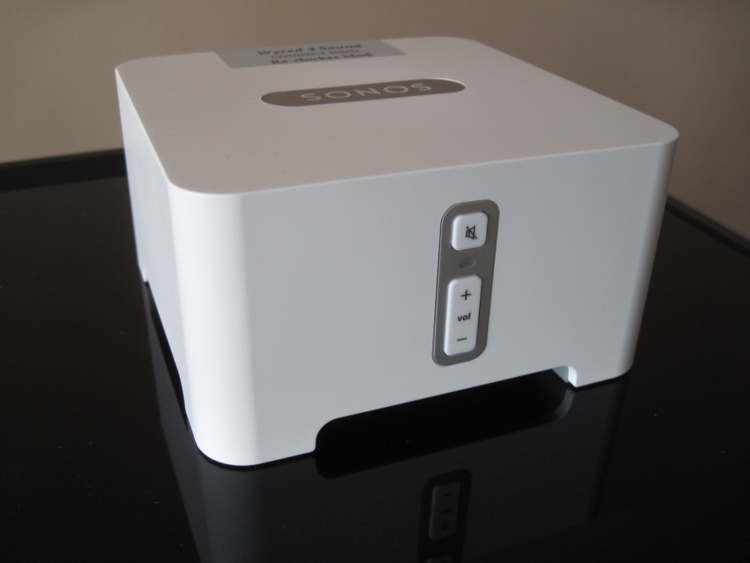
A versatile music streamer equipped with a high accuracy direct I2S upsampling digital coaxial output
Review sample supplied by Wyred4Sound
Retail price complete unit $890
Retail price mod only $550
Technical info
The Wyred4Sound Sonos upgrade entirely replaces the mediocre Cirrus Logic CODAC and the associated high jitter clocks. The upgrade consists of installing a new custom Wyred 4 Sound designed PCB that contains:
- High-end sample rate converter made by TI
- Low jitter clock with less than .5ps jitter
- Low noise power supply for the clock and SR
- Micro processor controller
- Input & output digital buffers
This new custom board is factory-installed in the SONOS and directly converts the I²S into up-sampled SPDIF. The resultant ultra clean low jitter signal is then available through both the Coax and Optical digital outputs. While Sonos doesn’t play hi-res material natively (up to 48kHz and 44.1kHz natively), the W4S board’s SPDIF output’s sample rate can be factory configured to 44.1, 48, 88.2, and 96kHz.
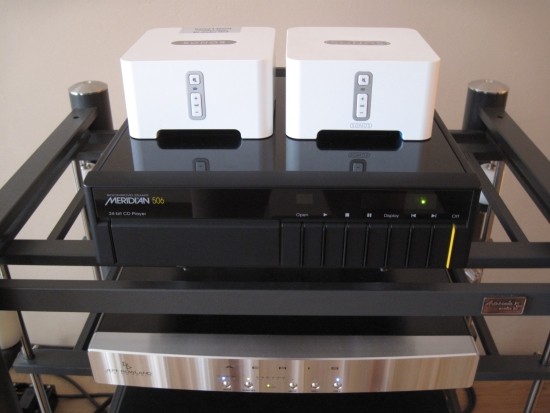
Above: W4S unit on the left, stock unit on the right
Background
The Connect (former ZP90), and ZP80 before that, have been around for what seems like ages, yet I have thus far resisted getting one. My holding off was due to earlier experiences with other computer audio products such as the Squeezebox and my later efforts to maximise playback from desktop and laptop computers. Ultimately I found that none sounded sufficiently good enough and went with the PS Audio PWD mkII which was later superseded by the Sooloos system (now referred to as MDMS or Meridian Streaming Audio), in the shape of an MD600 and 818 Reference Audio Core. That system was again superseded by the AAZ Ultra Flow music server in combination with the Jeff Rowland Aeris USB DAC, which is still my reference today for computer audio playback, or as I like to call it, Next Gen Audio playback.
Which brings me back to the Sonos Connect. I had played with it at a friend’s place and found the iPad interface quite accomplised, in some ways even comparable to Core Control iPad app, supplied for Sooloos. Sound quality at the time couldn’t be assessed but the interface had me intrigued. While I was enjoying my Sooloos system I had forgotten about Sonos altogether for a long time, until it occurred to me that it would be nice to have a secondary streamer in the bedroom. Which is when Sonos came back into the picture.
When searching the internet for info, one quickly stumbles on upgrades for the Connect. Most common are clock upgrades and digital output reclocking. Intrigued by this I decided to carry out some comparisons. I bought a used ZP90 and arranged a Sonos Connect from Wyred4Sound that includes their Reclocker modification. ZP90 and Connect are the very same machine, but the latter has better wifi functionality. And a grey underside instead of blue. I like the grey better but who cares, it’s about what’s inside. And there’s plenty added and replaced with the W4S mod. But first I would give the stock unit a listen.
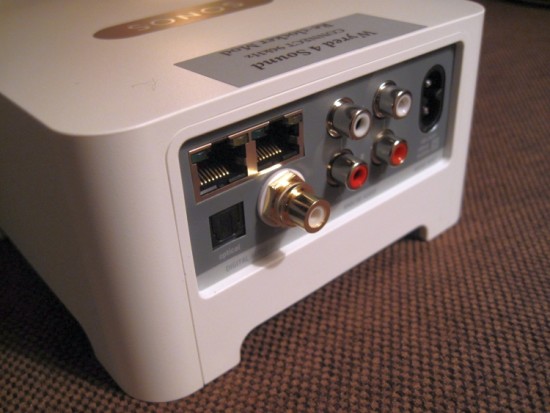
Above: Wyred4Sound also add a high quality SPDIF coax connector
Listening in stock form – analog out
Using its analog outputs, the Connect doesn’t sound bad at all. There’s no harshness, no agression and pretty good low level detailing. Where it performs less well is on timbre: it sounds smooth enough but isn’t very acoustically convincing, making a piano sound more like a synthesizer and robbing drums of their percussive power. Dynamics are also restrained and so is bass power and -articulation. The upside is that it makes most music very listenable, even badly recorded albums. But ultimately I miss a lot of communicative power. In short: the Connect reminds me of what a standard desktop computer with a standard Creative soundcard sounds like on its analog outputs: friendly and smooth and a bit fuzzy. This is not a bad achievement however, especially if you factor in its 350 euro price and what you get for it. But clearly, when speaking about the sound quality of its built in DAC alone, Sonos is no match for high end music systems such as those from Meridian.
Listening in stock form – coaxial digital out to the Jeff Rowland Aeris DAC
As expected, there’s a world of difference in sound from the Sonos playing directly (even if using a high end interlink such as the Transparent Ultra or Cardas Hexlink 5C) and the sound sent from its coaxial digital output, into the Jeff Rowland Aeris DAC. Bass tightens up and gains weight and articuation. Midrange is more powerful and more dynamic and treble is more articulate and open, also soundstage focus and imaging improves a lot. But still, timbre is off, and the Connect, even with help from this high end DAC, does not trick me into thinking that I am listening to the real thing. In fact: while the sound via the external DAC is technically better in all areas, emotionally it doesn’t help, because the sound becomes more technical and adds a “disconnected” quality. The Sonos’ analog output, mediocre as it is, still makes pleasant music and reminds me of the relaxed nature of classic Philips and Marantz CD players such as the CD880 and CD94, minus their transparency and dynamic articulation.
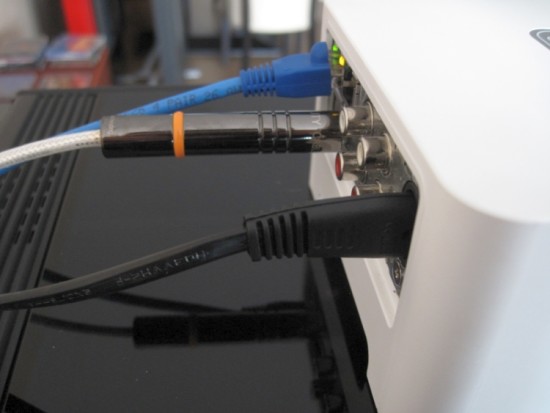
Switching digital cable
Normally I only use the Wireworld Gold Starlight III+ because it really complements most components with its fluid sound. For the Sonos I also tried the more accurate High Fidelity CT-1. And indeed this cable did improve focus, dynamics and bass transients. But the “out-of-pace” quality remained and I still found the Sonos to sound somewhat synthetic. Before I go to the comparison with the W4S modded Connect, let’s look at the functionality and the differences with a reference system such as Meridian’s Sooloos system.
Functionality
The Sonos system really is pretty fool-proof. In most cases you need not know anything about network addresses or any process remotely computer-like for that matter. As long as you are using a NAS (containing properly tagged material) that has UpnP connectivity, all is plug and play. The Connect and iPad are mated by simply pressing two buttons on the front of the unit after activating the function in the iPad and then all speaks for itself. I did not need the manual even once. In my case both the VortexBox and WD MyBook Live Duo’s respective media folders appeared automatically in the Sonos’ setup menu, ready for browsing. The Connect automatically scans the directory and creates a library which enables very quick browsing and extended search functionality. My Synology NAS did not appear automatically but in that case it is merely a matter of providing its IP address and login + password.
The iPad app works swiftly and offers a good overview. I would have liked to see a larger area for the playlist, but otherwise it really works well and even outperforms the industry standard Meridian Sooloos app (now referred to as MDMS or simply Meridian Streaming) on some accounts. Regular readers know that I am not happy with Sooloos but I’d like to stress that my writings are never about complaining but about urging the manufacturer to fix important bugs and thus make better products. Below is a comparison below, to point out how close the competition is getting.
What the Sooloos (MDMS) Core Control app does better:
- More advanced tagging functionality
- More advanced playlist control (delete, sort and more)
- More advanced searching (focus, exclude, combine several search terms, find related composers, co-players etc)
- Recently added items (last week, last month etc)
- Choice between overview of titles or album art
Similar functionality:
- Connect is just as speedy and stable as CoreControl
- While it doesn’t allow searching on intricate matters such as contributing album artists, the Sonos app does allow searching for artist, track title and album and such, as well as the option of showing related albums by the same artist.
- For both Sooloos and Sonos there’s a PC/Mac desktop application with the same functionality as the i-device app.
What the Sonos app does better:
- In addition to loading, editing and saving playlists (from currently playing), Sonos can also add tracks to existing playlists, even if they aren’t loaded to the now playing section.
- Selectable default click playlist actions such as always play now, always cue after current track or always add to end of playlist.
- Favorites can be created from the iPad app, not only from the desktop app.
- Sonos works with existing music databases and existing storage: as long as the tagging is in order, all will work flawlessly. Unlike with Sooloos, there’s no need to physically import audio into the closed Sonos system. In spite of this, search- and browse speed is similar between both systems.
So, I guess it is obvious by now that Sonos really made a very good system that for functionality more or less competes with what is widely regarded as the industry standard for streaming. At Meridian’s premium pricing one would expect that the soundquality doesn’t match up, and indeed it doesn’t. Actually the Sooloos system, when comprised of an MD600+818 represents the second best streaming audio system I have heard yet. But this system costs 40 times more than the Connect, which places it firmly out of reach of most music enthusiasts. So, the burning question is: with the functionality already being right up there, how much more soundquality can be squeezed from a Sonos Connect?
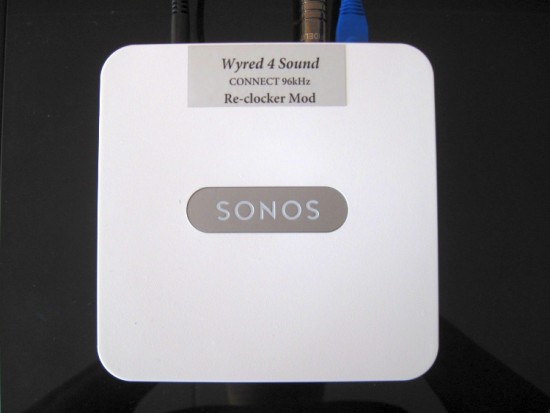
Listening to a Wyred4Sound-modded Connect – coaxial digital out to the Jeff Rowland Aeris DAC
The W4S mod doesn’t change the analog output but replaces the entire digital circuit from the I2S output while adding a choice of upsampling rates, which need to be set at the factory. W4S advise 96kHz unless the DAC is somehow designed to sound better with 44kHz. I chose 96kHz because I know that the Rowland Aeris works well with it.
Using the same power cable connected to the same power outlet and keeping an eye of polarity, I connected the W4S unit. With little warmup, in fact as little as the time it took to scan the Vortexbox’ contents and load the library, I listened to a range of tracks. Well, I needn’t have selected all those tracks as all it took was a few seconds of the first track to realise that this mod indeed makes the Connect sound a lot better than the stock unit!
Bass was more articulate and also more powerful, midrange was more focused and more lively and importantly, the treble retained its fluid character. The latter is likely a result of the 96kHz sample rate, which I am now really happy to have chosen because most of the time higher accuracy not only pertains to the bass and midrange but also to the treble which, when combined with a very revealing system such as mine, can lead to some dryness. Not here. The Sonos actually sounds very juicy. I even thought I detected more spaciousness than before, but this I will need to revisit in order to be sure. But already I can say that this upgrade really makes a big difference.
More listening after a few days of warming up – coaxial digital out to the Jeff Rowland Aeris DAC
Whether or not the warming up changed the sound I cannot really say. I think I’m hearing the same as a few days ago, so I guess that if there is burn in time, then it doesn’t do much. More listening did reveal that while the bass is definitely tighter and better-paced, it is still somewhat mellow. Many people will actually like this as it is easier on the ear and more forgiving of bad recordings, but for me it could be a little tighter. As long as the treble remains fluid, and that’s usually the downside of having tight bass.
In came the High Fidelity CT-1 cable again and this time it seemed to be the perfect match! Bass tightened up, as did the focus, and treble remained fluid. What more could you ask for. Since I changed my Magnepans for Apogees, I can’t detect this as easily anymore – all music sounds so much more acoustically convincing – but it seems that even with the W4S mod in place, there’s still the slightest hint of a synthetic sound signature. This is nothing to worry about as all products in this price range exhibit this, but it is important to note that the effect is much less distinct than with to the original. I now quite liked the sound!
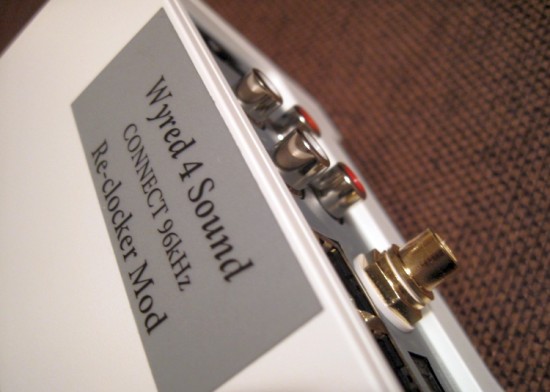
Final listening, compared to the AAZ Ultra FLow – USB out to the Jeff Rowland Aeris DAC
I should state up front that this is no fair comparison. The AAZ’s internal Vortexbox software has an advantage because the library is on the same machine. The AAZ therefore in this case cannot be classed as a network streamer and its music doesn’t need to travel over UTP cable. But it’s the only alternative I have at hand these days, after it beat the Meridian Sooloos reference system when combined with the Aeris DAC. Yes, the AAZ sounds better and of course it should. After all, its USB output card alone costs more than a stock Sonos Connect unit and the AAZ’s power supply alone is bigger than the whole Connect unit. Even if the Wyred4Sound mod takes the Connect up to 890 US dollars, the AAZ is still 3 times as expensive, and it doesn’t offer an analogue output. It does however offer integral storage and automated ripping, so, we’re talking different target audiences here.
But what are the audible differences? It’s not resolving power or imaging. The W4S-Connect is already way up there in those areas. Also, its treble is just as finely resolved and fluid as the AAZ’s, which is a big deal for me! The W4S’ bass is full and meaty and the midrange is voluptuous, so the end result is far from threadbare, but still, something missing. It’s the one area of sound that often gets overlooked but is a big factor for me lately, quite simply: timbre. The Stock Connect’s timbre isn’t very natural and I would even call it synthetic, just as I found the Sony XA50ES to sound synthetic compared to even the cheapest Wadia 12 DAC (or, to stay in more recent realms: PS Audio NWD or PWD MKII). The W4S-modded Connect improves massively in this respect. You really can hear that the digital signal is handled way more accurately. But still, the AAZ just sounds even more natural and more convincing to me. Wooden instruments sound more like wood and percussion sounds more percussive. And finally, bass is a little more solid and transients a little sharper. Is that enough to choose differently? For me it is, but I guess that’s a very personal matter, one driven by wallet size as well as system synergy. Please understand that my system is highly revealing. I can imagine that aspects such as timbre carry much less weight on more modest systems, in which the Connect is likely to be used.
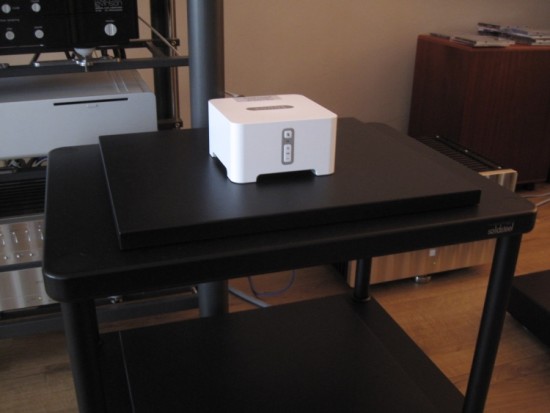
Tweaking
Regular readers know that I love to tweak. I wasn’t sure myself but even a device as seemingly futile as a Connect turns out to respond clearly to component feet and equipment racks. Thus far, the Connect was set up on top of a Meridian 506.24 CD player that itself sat on top of the Artesania Exoteryc equipment rack. Because of the Connect’s small footprint, it couldn’t be set up directly on the Artesania rack, yet, somehow I think there was a synergy going on with the humble Meridian CD player as its pedestal. The result was as described above: a pleasantly smooth and rich, abeit slighly synthetic sound with bass that could be a little tighter. Bring in the tweaks!
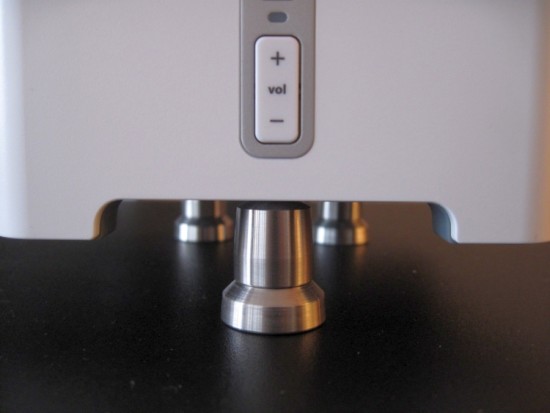
First mod was to position the Connect on top of the new SolidSteel S5 audiorack. Sceptics aware… this made a big difference in sound: bass was tighter and seemingly faster but midrange was a bit gray and treble was drier. It’s all about synergy but I guess you could say that in this case the Artesania+Meridian combination made for a more luxurious sound but the SolidSteel rack presented a more dynamically and rhythmically correct sound. For me however this was a little too gray so I connected the Wireworld cable instead of the CT1 again. Ah yes, much smoother. But now I missed the nice bass-tightness, so dug out the Stillpoints Ultra Mini footers. I know this is insane given the relation between Sonos and Stillpoint pricing but I’m using them here to make a point: even with the Connect, footers make a clearly audible difference! With the Ultras in place the bass firmed up again but without tipping the balance over into the gray direction.
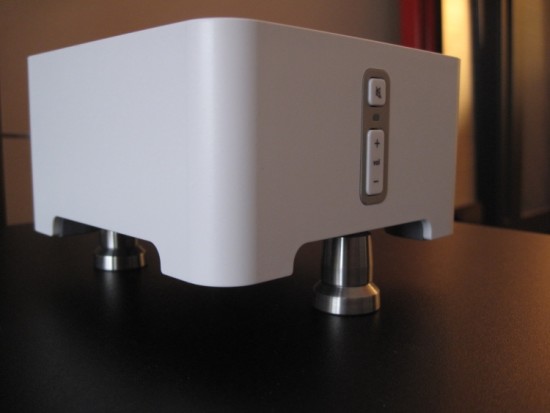
Lastly I added an Artesania weight on top of the Connect, mostly because the cables were pulling at its behind. Lo and behold: this finished it off! Bass became a lot weightier while retaining tightness and attack, the sound became more luxurious and most impressively, the timbre became more natural. Whatever artificiality/synthetic sound signature was still present, was very, very mild. Of course you don’t have to use Stillpoints, Artesania weights and a SolidSteel rack, these products just go to show that you can quite dramatically change the character of even a humble product such as the Sonos Connect. If you have the cash then by all means go and obtain some Finite Elemente Ceraballs or Stillpoints but you could probably also use steel cones, a brick on a layer of rubber and an Ikea table with good results. Don’t forget however that what started this was the Wyred4Sound modification. Without it, I found, the Connect will never perform to my satisfaction, no matter how many tweaks I throw at it.
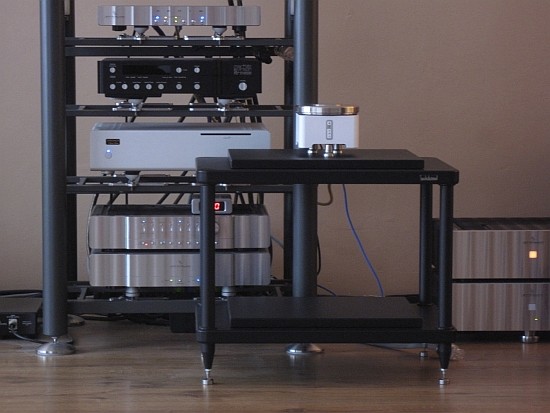
In addition to the standard Sonos interface, there’s also an independent app in the Apple App Store for the Sonos Connect called SonoPad. It costs a few Euro but I strongly suggest checking it out. It has a massively improved, more classy user interface and it has incorporated some of the Sooloos functionality such as selectable default click action (play now, add to cueue etc), separate buttons for most used actions, a larger playlist with sorting functionality, larger artwork and a lot more. In the Wyred4Sound guise, the sound quality is unbeatable at the price and the standard user interface is already competitive. I bet that if we all support the maker of SonoPad, I’m sure he could improve the app even further, bringing the Sonos Connect ever closer to the rich experience that is possible with state of the art products.
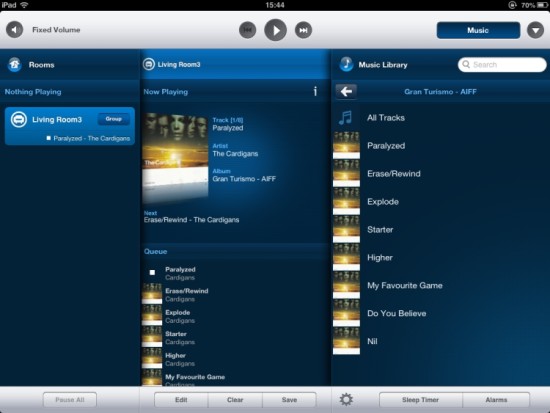
Above: Standard Sonos interface
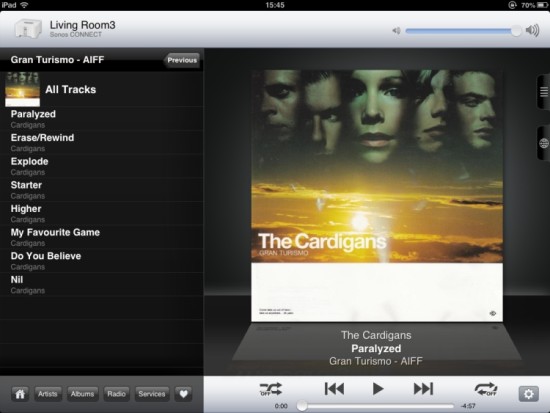
Above: SonoPad Sonos interface
Tip:
Apparently Sonos has a 65.000 track limit. Because I’m very precise in what I gather, my library doesn’t begin to approach that number, but if yours does, then apparently there is a way around this by means of importing playlists.
Conclusion
Let me put it such that it makes it all clear: the stock Connect for me is nice enough but simply below par. I can’t listen to it very long before losing interest. The W4S-modded Connect is a different story: it is so good that I can actually listen to it with pleasure, and a tapping foot. Consider that for a spoilt brat like myself.
In the Wyred4Sound guise, the sound quality is simply unbeatable at the price and the user interface offers almost all the functionality that you could wish for.
From experience with the dCS Delius and Purcell I know that not using a whole multiple of 44kHz results in a more fluid, but also less articulate sound. When I lived with the dCS couple, I always used 88.2kHz for the perfect combination of treble air and bass tightness. The 96kHz setting for my W4S Connect may well be the best option but I can imagine that the bass will be tighter and more dynamic when the unit is set to 88.2kHz. However, the treble, which I now like a lot, may become drier. Also, I am also aware that my system doesn’t possess the tightest bass or have the most dynamic behaviour possible, so your mileage may vary.
Now, what if W4S would also come up with a power supply modification. An external one preferably. I am certain that would improve the Sonos even further. But it would also drive the price up, perhaps quite a lot, which would likely move the Connect out of reach for a lot of people. As it is, the modded Connect I think is priced just right. It really outperforms the stock unit by a large margin and I can heartily recommend it to all Sonos owners that want to know what their Connect is really capable of.
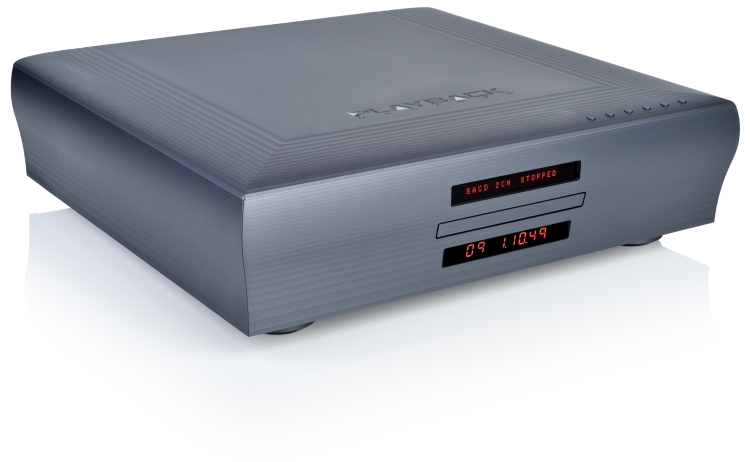







No doubt, I appreciate your efforts and attention to detail. Your observations coincide with mine in many ways. As an electrical design engineer with 25 years of audiophile enthusiasm, upgrades and mods, yada yada, I realize it takes that deep level of involvement to squeeze out every last drop of emotion in the music we so enjoy. This emotional conveyance is precisely what a musician feels and sweat for. As humans, we simply long to connect with our source and as audiophiles, we long to connect with the source of emotion conveyed in the music. This of course, is no mystery to any true audiophile but what is mysterious is the material science that connects the physical world with emotion. Audio Engineers alike, still do not have a consensus on an absolute physicality and it’s relationship to emotional effects on a consensus population…I ask, how amazing is nature?
I digress. In any case, all of that just to say tonight I tried my stock SONOS Connect connected to my Meridian 568 digital input with a simple stock Toslink after over 6 months of critical listening with my Cardas Clear RCA cable into a Meridian digital input.
I’m reborn. The marriage of Sonos, Toslink and Meridan 568 DAC Processor, McCormack DNA 2.o Rev B, Audio Physic Virgo Rev II is incredible with pronounced and substantial improvements in musicality, dynamics and overall emotional involvement. Depth of sound stage and tonal decay are magnitudes beyond expectation. Notes seem to pierce new depths both spatially and emotionally with a sparkle that leaves me bewildered, how a such a seemingly benign act could transform my familiar friend into a stranger. Just thought you might want to entertain the idea.
Thanks for sharing! Indeed the audio world is not linear and many things are very much relative. I can certainly imagine that in a given setup Toslink can provide a more emotionally appealing sound, even if it is technically likely less accurate. Although my current setup requires technically accurate reproduction on the source side and Toslink always sounds more rounded off in this context, with previous setups it has long been my conviction that digital playback can also be overdone, and that a slightly mellowed presentation (even if this is achieved through worse jitter or reduced transient attack) can sound more involving. Even dynamics can seem better if the overly tight grip has been removed. I always say: trust your ears! After all, you are the one who has to enjoy the sound of your system. You may want to investigate the better Toslink cables that use real glass fibre, such as those made by Lifatec for about 100 euro. These cables mostly retain the Toslink characteristics (decoupled/free-flowing sound) but allow for better transient behaviour and sound slightly more open.
i see from your photo that you’re using ethernet connection on the wyred sonos connect. Could you discern any SQ difference between ethernet and wireless connections on the wyred sonos connect since the fave right now is ethernet renderer?
I don’t believe that I compared wifi and ethernet with the Sonos Connect. The review in any event was based solely on its ethernet performance. Alas I don’t have the unit any longer and so can’t make the comparison now.
Christiaan,
Great article. Very helpful as I look for an alternative to my current whole house streaming with Logitech Squeezebox. Now that I know there is a way to upgrade the Connect for my critical listening room/theater, I should have all bases covered. Noticed that W4S now makes an external power supply. Also going to audition the new Arcam rPlay.
Thanks Again – Cheers.
Hi Steven, glad you like the article. If you’re serious about SQ, you should also consider Roon. Once you purchased the license (which can seem expensive but really isn’t) you are home free. Choose between super high end endpoints or make your own using Raspberry Pi and free Roon software. Or use your existing Squeeze items (software or hardware), or even Sonos. Roon is very widely compatible, and even when using Squeezelite protocol it sounds better than Sonos. For more info check all the Roon articles on this site.